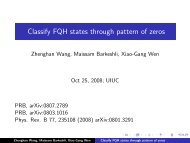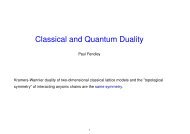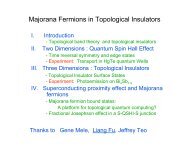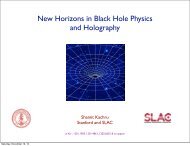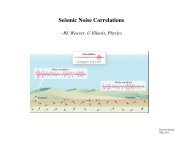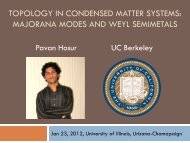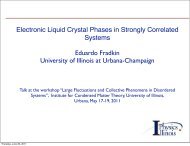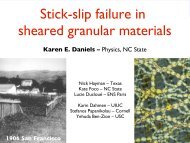Gil Young Cho - Institute of Condensed Matter Theory at the U of I
Gil Young Cho - Institute of Condensed Matter Theory at the U of I
Gil Young Cho - Institute of Condensed Matter Theory at the U of I
You also want an ePaper? Increase the reach of your titles
YUMPU automatically turns print PDFs into web optimized ePapers that Google loves.
UIUC, Feb 5 th (2013)<br />
Superconductivities <strong>of</strong><br />
doped Weyl semimetals<br />
Phys. Rev. B. 86, 214514 (2012) - Editors’ suggestion<br />
<strong>Gil</strong> <strong>Young</strong> <strong>Cho</strong><br />
UC Berkeley<br />
Jens H Bardarson<br />
Yuan-Ming Lu<br />
Joel E Moore
Plan.<br />
• Part 1 : superconductivities <strong>of</strong> doped WSM<br />
– Motiv<strong>at</strong>ions, Weyl semimetals?<br />
– BCS or FFLO superconductivity?<br />
– Topological Defects in FFLO SC-ivity<br />
UIUC, Feb 5 th (2013)<br />
• Part 2 : Proxim<strong>at</strong>e phases <strong>of</strong> Z2 spin liquid on<br />
Kagome l<strong>at</strong>tice (GYC, YML and AV, in prepar<strong>at</strong>ion)<br />
• Z2 spin liquid in Kagome l<strong>at</strong>tice<br />
• Proxim<strong>at</strong>e phases <strong>of</strong> Z2 spin liquid<br />
Ashvin<br />
Vishwan<strong>at</strong>h
Part 1.<br />
I. Superconductivity<br />
<strong>of</strong> doped Weyl semimetals<br />
Hedgehogs in momentum space
Weyl semimetals = 3D graphene?<br />
• graphene? Dirac fermion in 2D<br />
Honeycomb l<strong>at</strong>tice <strong>of</strong> graphene<br />
H = v D (σ x k x + σ y k y ) − μ Here σ<br />
a<br />
acts on subl<strong>at</strong>tice basis<br />
(A-B subl<strong>at</strong>tice)
Weyl semimetals = 3D graphene?<br />
graphene: H = v D (σ x k x + σ y k y ) − μ<br />
Weyl SM: H = v D (σ x k x + σ y k y + σ z k z ) − μ<br />
~ two-component Weyl fermion in HEP<br />
In general, WSM is described by<br />
H = v a ⋅ q σ a<br />
a=1..3<br />
with <strong>the</strong> chirality c = sgn ( v 1 ⋅ v 2 × v 3 )<br />
M<strong>at</strong>erial: irid<strong>at</strong>es, layered top. Ins., TlBi Se 1−x S x 2 , HgCr2Se3
Wh<strong>at</strong> is interesting in WSM?<br />
Ref. Wan et. al. (2011), Hosur et. al. (2012), Burkov et.al. (2011), Yang et.al. (2011)<br />
A. “robust-ness” <strong>of</strong> Weyl nodes:<br />
- no mass term for a single Weyl node: e.g H = v σ ⋅ k<br />
- “pair annihil<strong>at</strong>ion” is <strong>the</strong> only way to gap out!<br />
B. “fl<strong>at</strong>” fermi arc surface st<strong>at</strong>e<br />
C. three-dimensional anomalous Hall effect: σ xy ~ Δθ e2<br />
D. interesting transport phenomena<br />
E. Need to break time-reversal or/and inversion symmetry<br />
h<br />
Review article: Ari Turner, and Ashvin Vishwan<strong>at</strong>h, arxiv: 1301.0330 (2013)
Where can we find<br />
Weyl semimetal phase?<br />
Topological insul<strong>at</strong>or<br />
+ “large enough” Time-reversal symmetry breaking<br />
M<strong>at</strong>erial: Fe/Cr doped TlBi Se 1−x S x 2<br />
Ref. Burkov et.al. (2011), <strong>Gil</strong> <strong>Young</strong> <strong>Cho</strong> (2011)
“Top. Ins.”-based Weyl semimetals<br />
• Minimal model for Topological Insul<strong>at</strong>ors<br />
H = v D τ z σ ⋅ k + τ x M<br />
Ref. <strong>Gil</strong> <strong>Young</strong> <strong>Cho</strong> (2011)<br />
e.g. near <strong>the</strong> Γ-point in Bi 2 Se 3<br />
τ a : orbital degrees <strong>of</strong> freedom<br />
σ a : spin degrees <strong>of</strong> freedom<br />
• We add a time-reversal breaking term coming<br />
from magnetic impurities (e.g. Fe or Cr) in bulk<br />
H zeeman = mτ 0 σ z
“Top. Ins.”-based Weyl semimetals<br />
H = v D τ z σ ⋅ k + τ x M + mσ z<br />
• Spectrum for m > M<br />
E<br />
K Z ∗ = ± m 2 − M 2<br />
away from <strong>the</strong> high sym. point<br />
Winding # is -1<br />
Γ<br />
Winding # is +1<br />
Kz<br />
Ref. <strong>Gil</strong> <strong>Young</strong> <strong>Cho</strong> (2011)
“Top. Ins.”-based Weyl semimetals<br />
Insul<strong>at</strong>or<br />
Insul<strong>at</strong>or<br />
M<br />
m<br />
a. Top. Ins. – Triv. Ins.<br />
transition ≈ a fourcomponent<br />
Dirac<br />
fermion.<br />
b. A four-component<br />
Dirac fermion can<br />
be “splitted” into a<br />
pair <strong>of</strong> twocomponent<br />
Weyl<br />
fermions<br />
M<strong>at</strong>erial: Fe- or Cr- doped TlBi Se 1−x S x 2<br />
Ref. <strong>Gil</strong> <strong>Young</strong> <strong>Cho</strong> (2011)
Superconductivities <strong>of</strong><br />
doped Weyl semimetal?<br />
Fermi surfaces due to doping<br />
+<br />
Attractive interactions<br />
between <strong>the</strong> electrons
Why superconductivities?<br />
GY <strong>Cho</strong>, J Bardarson, YM Lu, and JE Moore, Phys. Rev. B. 86, 214514 (2012)<br />
I. Strong spin-orbit coupling<br />
e.g. A doped topological Insul<strong>at</strong>or can<br />
become a topological superconductor<br />
II. Topological Winding # around Weyl nodes<br />
III. Disconnected Fermi pockets<br />
for small doping
GY <strong>Cho</strong>, J Bardarson, YM Lu, and JE Moore, Phys. Rev. B. 86, 214514 (2012)<br />
In this talk:<br />
Study possible superconducting<br />
st<strong>at</strong>es emerging from a doped<br />
Weyl semimetal
Our approach is…<br />
Following <strong>the</strong> spirit <strong>of</strong> Fu and Berg (2010)<br />
A. Consider a “minimal” model for a Weyl<br />
semimetal & dope <strong>the</strong> model slightly<br />
B. Add a “phenomenological” <strong>at</strong>tractive<br />
interaction to <strong>the</strong> model<br />
C. Classify possible superconductivities<br />
D. Compare energies <strong>of</strong> SC st<strong>at</strong>es
Minimal L<strong>at</strong>tice model for Weyl semimetals<br />
Ref. Yang et.al (2011)<br />
A. The minimal model has two bands touching each o<strong>the</strong>r <strong>at</strong> two Weyl points<br />
E<br />
It can be modeled with “spin-ful”<br />
electrons c ↑,↓ with spin-orbit coupling in<br />
a cubic l<strong>at</strong>tice :<br />
Γ<br />
Kz<br />
c i,↑<br />
c j,↓<br />
site i<br />
site j<br />
H = −iλ SOI<br />
{ c i,α ∗ σ x αβ c i+x,β + c i,α<br />
∗<br />
σ y αβ c i+y,β } + h. c<br />
+M c i,α ∗ (σ z )c i,β − t {c i,↑ ∗ c j,↑ − c i,↓ ∗ c j,↓ }<br />
- Pauli m<strong>at</strong>rices σ a acts on <strong>the</strong> spin index ↑, ↓ <strong>of</strong> <strong>the</strong> electron c ↑/↓
Minimal L<strong>at</strong>tice model for Weyl semimetals<br />
Ref. Yang et.al (2011)<br />
Minimal model on cubic l<strong>at</strong>tice (broken time-reversal symmetry)<br />
H = H 1 k x , k y , M + H 2 (k z , m)<br />
H 1 k x , k y , M = σ x sin k x + σ y sin k y + Mσ z (2 − cos k x − cos k y )<br />
H 2 k z , m<br />
= mσ z (cos k z − cos Q)<br />
Important properties <strong>of</strong> <strong>the</strong> Hamiltonian<br />
I. Two Weyl nodes <strong>at</strong> k z = ±Q and k x = k y = 0<br />
II. no spin rot<strong>at</strong>ional symmetry ( spin~〈σ a 〉 )<br />
(~ strong spin-orbit coupling)<br />
III. symmetry = l<strong>at</strong>tice symmetry C 4h<br />
(~ pairing should be classified by C 4h )
Doping <strong>the</strong> minimal model<br />
A. There are two “fermi pockets” around <strong>the</strong> nodes with<br />
“spin-momentum locking”<br />
e.g. near <strong>the</strong> upper node<br />
H + = σ x k x + σ y k y + σ z (k z −Q) − μ<br />
Note: winding around <strong>the</strong> node is ±1<br />
B. To study a superconducting instabilities, we<br />
add a “simplest” on-site <strong>at</strong>tractive interaction<br />
δH = −V 0<br />
r<br />
n ↑ (r)n ↓ (r)<br />
e.g. phonon-medi<strong>at</strong>ed <strong>at</strong>tractive interaction
Possible BCS superconducting st<strong>at</strong>es<br />
A. The interaction is completely “local” and thus<br />
<strong>the</strong> electrons are paired in “singlet” channel<br />
(due to Pauli’s exclusion principle).<br />
Pairing interaction is local in real space<br />
= pairing gap is constant in momentum space<br />
B. So <strong>the</strong> mean-field st<strong>at</strong>e should be “singlet” BCS pairing<br />
δH = Δ ψ ∗ u k ψ∗ d<br />
−k + h. c.<br />
note: <strong>the</strong> total momentum carried by <strong>the</strong> pairing is zero;<br />
so it should be “inter”-nodal pairing
Possible BCS superconducting st<strong>at</strong>es<br />
BCS st<strong>at</strong>e: “inter-nodal” + “singlet” (trivial rep <strong>of</strong> <strong>the</strong> l<strong>at</strong>tice sym.)<br />
Note: To be paired in singlet channel, spins need to be anti-parallel<br />
The nodes are “Weyl” nodes !
Possible FFLO superconducting st<strong>at</strong>es<br />
A. There is ano<strong>the</strong>r competing superconducting st<strong>at</strong>e<br />
for <strong>the</strong> doped Weyl semimetal ~ FFLO pairing<br />
(FFLO st<strong>at</strong>e: “intra-nodal” + “singlet” )<br />
δH = Δ ± ψ ∗ u ±Q + k ψ∗ d<br />
±Q − k + h. c.<br />
note: <strong>the</strong> pairing “Δ ± ” carry<br />
crystal momenta ±2Q<br />
note: this FFLO is fully gapped<br />
B. Why this st<strong>at</strong>e can be better than BCS st<strong>at</strong>e?<br />
- <strong>the</strong> effective “DOS” particip<strong>at</strong>ing to <strong>the</strong> BCS<br />
pairing is reduced because <strong>the</strong> spin st<strong>at</strong>es <strong>at</strong> k<br />
and −k are not anti-parallel.<br />
- However, FFLO st<strong>at</strong>e connects anti-parallel<br />
spins
Mean-field Energy <strong>of</strong> superconducting st<strong>at</strong>es
So..<br />
FFLO st<strong>at</strong>e wins against BCS st<strong>at</strong>e<br />
in <strong>the</strong> doped Weyl semimetal
Physical properties <strong>of</strong><br />
FFLO superconductivity in WSM<br />
??
FFLO superconducting st<strong>at</strong>es<br />
A. We have two independent pairings “Δ ± ” for each node<br />
δH = Δ ± ψ ∗ u ±Q + k ψ∗ d<br />
±Q − k + h. c.<br />
which can be compactly written as a wave in real space<br />
Δ r<br />
= Δ cos(2Q ⋅ r + δφ)<br />
a. so <strong>the</strong>re should be “density modul<strong>at</strong>ion” in FFLO st<strong>at</strong>e<br />
b. center <strong>of</strong> momentum is fixed by <strong>the</strong> positions <strong>of</strong> Weyl nodes<br />
(in <strong>the</strong> irid<strong>at</strong>es, we have 24 Weyl nodes)<br />
B. FFLO st<strong>at</strong>e has a half-quantum vortex and a usual full quantum vortex<br />
half-quantum vortex : a unit winding in only one <strong>of</strong> <strong>the</strong> two pairings<br />
full quantum vortex: a composite <strong>of</strong> two half-quantum vortices<br />
Any “exotic” interesting bound st<strong>at</strong>e to <strong>the</strong>se vortices?
Lesson From superconducting doped Top. Ins.<br />
Any interesting bound mode to vortex?<br />
Ref. Fu and Berg (2010)<br />
Example. Topological SC from a doped Topological Insul<strong>at</strong>or CuBiSe<br />
E<br />
i) Fermi surface is two-fold<br />
degener<strong>at</strong>e, rel<strong>at</strong>ed by T-<br />
symmetry<br />
kx<br />
ii)<br />
Each fermi surface encloses a<br />
non-trivial winding # +1 or -1<br />
iii) Vortex realizes “two zero modes”<br />
rel<strong>at</strong>ed by T-symmetry, or “a<br />
helical Majorana mode”<br />
γ ↑,k = γ ∗ ↑,−k<br />
, E = +vk<br />
γ ↓,k = γ ∗ ↓,−k<br />
, E = −vk<br />
Vortex
Similarty & Difference from doped Top. Ins.<br />
Similarities<br />
i) Fermi surface encloses a winding #<br />
ii)<br />
Fully gapped (robust topological fe<strong>at</strong>ure)<br />
Differences<br />
i) No time-reversal symmetry<br />
= no helical st<strong>at</strong>e; <strong>at</strong> best chiral or gapped<br />
st<strong>at</strong>es <strong>at</strong> vortex<br />
ii)<br />
Order parameter space = S 1 × S 1 in FFLO,<br />
instead <strong>of</strong> S 1 in usual SC<br />
= more topological defect types in FFLO<br />
= half-quantum vortex in FFLO<br />
e.g. spinful p+ip superconductor; we have<br />
a direction d ∈ S 1 and a phase e iθ ∈ S 1<br />
see Ivanov (2000)
Half-quantum vortex in FFLO superconducting st<strong>at</strong>es<br />
A. Half-quantum vortex corresponds to<br />
arg(Δ + ) → arg(Δ + ) + 2π<br />
arg Δ − → arg(Δ − )<br />
i.e., only <strong>the</strong> phase <strong>of</strong> Δ + winds once<br />
B. The Fermi surface around <strong>the</strong> node carries<br />
a unit “topological” winding number<br />
C. Hence <strong>the</strong>re is ‘a zero mode’ or a chiral Majorana<br />
mode in <strong>the</strong> half-quantum vortex.<br />
(i.e., γ k = γ ∗ , E = +vk)<br />
−k<br />
A quick way to see a chiral zero mode in <strong>the</strong> vortex:<br />
One node <strong>of</strong> <strong>the</strong> doped Weyl semimetal is “half” <strong>of</strong><br />
<strong>the</strong> “topological superconductor”
Possible Majorana mode <strong>at</strong> a full vortex<br />
A. Bring two half-quantum vortices with opposite chiral Majorana modes<br />
Half-quantum vortices<br />
B. In <strong>the</strong> vortex, we have a “helical” Majorana mode which is not protected<br />
C. The helical Majorana mode will be gapped<br />
D. There are two possibilities for <strong>the</strong> gapped phase;<br />
weak pairing and strong pairing phases<br />
ref. Kitaev (2000)<br />
E. In <strong>the</strong> weak pairing phase, we have a bound Majorana zero mode<br />
<strong>at</strong> <strong>the</strong> end <strong>of</strong> <strong>the</strong> vortex<br />
A dangling<br />
Majorana<br />
mode<br />
Full quantum vortex
Conclusion<br />
I. We found FFLO st<strong>at</strong>e is competing with BCS<br />
st<strong>at</strong>e (FFLO is energetically better than BCS<br />
in our model)<br />
II. FFLO st<strong>at</strong>e<br />
I. Density modul<strong>at</strong>ion with <strong>the</strong> momenta fixed by<br />
position <strong>of</strong> Weyl nodes<br />
II.<br />
Chiral Majorana mode <strong>at</strong> half-quantum vortex<br />
III. Possible Majorana zero mode <strong>at</strong> full vortex
UIUC, Feb 5 th (2013)<br />
Part 2.<br />
II. Proxim<strong>at</strong>e phases<br />
<strong>of</strong> Z 2 spin liquid on Kagome l<strong>at</strong>tice<br />
(<strong>Gil</strong> <strong>Young</strong> <strong>Cho</strong>, Yuan-Ming Lu and Ashvin Vishwan<strong>at</strong>h, in prepar<strong>at</strong>ion)<br />
Yuan-Ming<br />
Lu<br />
Ashvin<br />
Vishwan<strong>at</strong>h
Z 2 spin liquid on Kagome l<strong>at</strong>tice<br />
• Heisenberg interaction on Kagome l<strong>at</strong>tice :<br />
M<strong>at</strong>erials: dMIT, Herbertsmithite<br />
DMRG studies found a Z2 spin liquid!<br />
A. Gapped<br />
B. Topological Entanglement Entropy<br />
Ref. Yan Huse and White (2011)<br />
Jiang Wang and Balents (2012)
Which Spin liquid ?<br />
Ref. Hastings (2000)<br />
Ran, Hermele, Lee, and Wen (2007)<br />
Hermele, Ran, Lee, and Wen (2008)<br />
• Many different spin liquids from <strong>the</strong> fermionic rep. <strong>of</strong> spin-1/2<br />
The (rel<strong>at</strong>ively) low energy st<strong>at</strong>e<br />
is, “U(1) Dirac spin liquid“<br />
(among <strong>the</strong> fermionic SL ans<strong>at</strong>z)<br />
This st<strong>at</strong>e fe<strong>at</strong>ures:<br />
A. Dirac spectrum for fermions<br />
B. U(1) Gauge <strong>the</strong>ory<br />
Not consistent with DMRG result
Is <strong>the</strong>re a Z2 spin liquid near <strong>the</strong> U(1)<br />
Dirac spin liquid?<br />
Ref. Lu, Ran, and Lee (2011)<br />
Requirement 1: gauge <strong>the</strong>ory should be broken from U(1) to Z2<br />
Pairing <strong>of</strong> Dirac fermions!<br />
Requirement 2: Invariant under <strong>the</strong> l<strong>at</strong>tice symmetry oper<strong>at</strong>ion<br />
+ Invariant under <strong>the</strong> spin rot<strong>at</strong>ion oper<strong>at</strong>ion<br />
Requirement 3: Pairing should gap out <strong>the</strong> Dirac fermion<br />
There is one and only one such<br />
pairing s<strong>at</strong>isfying <strong>the</strong> requirements!<br />
s-wave pairing <strong>of</strong> Dirac fermion
Wh<strong>at</strong> can we tell about this Z2 st<strong>at</strong>e?<br />
(<strong>Gil</strong> <strong>Young</strong> <strong>Cho</strong>, Yuan-Ming Lu and Ashvin Vishwan<strong>at</strong>h, in prepar<strong>at</strong>ion)<br />
Our claim is:<br />
If this Z2 spin liquid is <strong>the</strong> spin liquid found in DMRG study,<br />
it should have very specific proxim<strong>at</strong>e phases separ<strong>at</strong>ed<br />
by a continuous transition from <strong>the</strong> spin liquid.<br />
A. Q=0 non-collinear magnetic ordered st<strong>at</strong>e<br />
B. VBS phase with <strong>the</strong> very specific bond-bond correl<strong>at</strong>ion
Proxim<strong>at</strong>e phases<br />
Special 5-tuplets <strong>of</strong> masses <strong>of</strong> Dirac fermions<br />
= WZW term for 5-tuplet masses<br />
= Unconventional second order transitions<br />
Ref. Wiegmann and Abanov (2000), Senthil and Fisher (2006), Grover and Senthil<br />
(2008), Ryu, Mudry, Hou, and Chamon (2009), Herbut (2010) etc.<br />
Underlying physics <strong>of</strong> WZW term:<br />
• topological defect in one phase carries <strong>the</strong> quantum numbers<br />
rel<strong>at</strong>ed to <strong>the</strong> o<strong>the</strong>r phase<br />
• Condens<strong>at</strong>ion <strong>of</strong> <strong>the</strong> defect = destroying one ordering<br />
+ inducing <strong>the</strong> o<strong>the</strong>r order
Q=0 non-collinear magnetic order<br />
and Z2 spin liquid<br />
Monopole quantum #s <strong>of</strong> U(1) SL<br />
Vison∼ spin-1/2<br />
Q = 0 st<strong>at</strong>e
Q=0 non-collinear magnetic orders<br />
n r =<br />
V=
Result :<br />
Sachdev (1992)<br />
=<br />
Continuous transition<br />
?!
N<strong>at</strong>ure <strong>of</strong> <strong>the</strong> VBS phase<br />
Order parameters for VBS p<strong>at</strong>tern N are <strong>at</strong> M-points in BZ<br />
• At least two <strong>of</strong> M-points should particip<strong>at</strong>e<br />
• All <strong>the</strong> l<strong>at</strong>tice symmetries (except transl<strong>at</strong>ional symmetries) are broken<br />
• 12-site unit cell (“quadrupled” unit cell)<br />
e.g. Diamond p<strong>at</strong>tern found in DMRG has 12-site unit cell p<strong>at</strong>terns<br />
Two Dirac nodes<br />
BZ<br />
ky<br />
M- points<br />
kx
Ex. Bond ordering p<strong>at</strong>terns <strong>at</strong> M-points<br />
BZ
Ex. Bond ordering p<strong>at</strong>terns <strong>at</strong> M-points<br />
BZ
Conclusion<br />
I. We have studied <strong>the</strong> proxim<strong>at</strong>e symmetry<br />
broken phases <strong>of</strong> a particular Z2 spin liquid<br />
II. Q=0 non-collinear magnetic ordered st<strong>at</strong>e<br />
- This allows us to identify <strong>the</strong> fermionic Z2 spin liquid as<br />
<strong>the</strong> bosonic Q1=Q2 spin liquid<br />
III. VBS st<strong>at</strong>e<br />
- superposition <strong>of</strong> VBS p<strong>at</strong>terns <strong>at</strong> M-points<br />
- 12-site unit cell with broken l<strong>at</strong>tice symmetries<br />
IV. More direct probe?
Thanks!<br />
My previous research:<br />
(1) Topological BF <strong>the</strong>ory description <strong>of</strong> topological Insul<strong>at</strong>or (2011)<br />
(2) Quantum Phase transition and fractionaliz<strong>at</strong>ion in a topological insul<strong>at</strong>or thin<br />
film with Zeeman and excitonic masses (2011)<br />
(3) Weyl semimetal in magnetically doped topological insul<strong>at</strong>or (2011)<br />
(4) Dyon condens<strong>at</strong>ion in topological Mott insul<strong>at</strong>or (2012)<br />
(5) Gapless edge st<strong>at</strong>e <strong>of</strong> BF field <strong>the</strong>ory and Z2 spin liquids, (2012)<br />
(6) Superconductivities <strong>of</strong> doped Weyl semimetals, (2012)<br />
(7) Two dimensional symmetry protected phases with PSU(N) and time reversal<br />
symmetry, (2012)<br />
(8) Proxim<strong>at</strong>e phases <strong>of</strong> Z2 spin liquid on Kagome l<strong>at</strong>tice, in preparetion<br />
My collabor<strong>at</strong>ors:<br />
C. Xu<br />
(UCSB)<br />
J. E. Moore<br />
(UCB)<br />
Y.B. Kim<br />
(U Toronto)<br />
Y.-M. Lu<br />
(UCB)<br />
A. Vishwan<strong>at</strong>h<br />
(UCB)<br />
J.H Bardarson<br />
(UCB)



